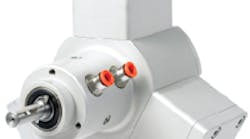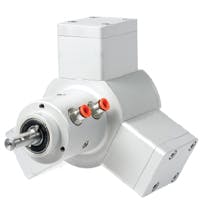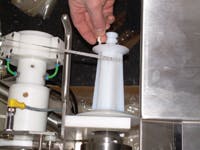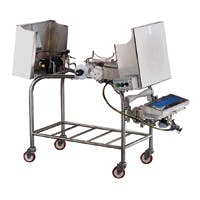Edited by K.Korane
Contributing Editor
According to Brian Newman of Greydon, Inc., York, Pa., a supplier of equipment for form, fill, and seal packaging machines for the food, medical, and pharmaceutical industries, his engineers had been searching for a cost-effective motor with the capability to precisely advance bags on the film-packing station of a new meat and cheese bagger. The GTBL-1000 Bagaire taped-bag loader needed precision advance and control not only for bag opening and filling, but also for code-dating with the non-contact ink jet or contact wet ink printers that are part of Greydon’s Codeaire Dating Systems.
Electric motors, they found, would be cost-prohibitive when modified to withstand the 100% caustic washdown environment of meat packaging lines. In addition, minimizing electronic components was important in this extreme environment.
And yes, size mattered.
An air motor from Huco Dynatork, Hertford, Hertfordshire, U.K., fit the application perfectly, explained Newman. “The Dynatork is a nice compact unit that fits in a snug space under the machine,” he says. “Bags are opened with a puff of air from the pneumatic system, so to have an air motor was the ideal situation.”
The GTBL-1000, Newman explained, advances the bags by winding up a leader tape and pulling the bags up from under the table. Plant air is used via an air amplifier to blow open the bags for manual filling by the operator, who simultaneously breaks the bag away from the tape. Bags in boxes or on rolls can be used in sizes up to 20-in. wide by 36-in. long.
The machine, connected to conveyors on both ends, matches up well to vacuum-chamber machines and various sealers, according to Newman.
“It totally revolutionizes the way in which bags are presented to the operator for loading product,” Newman said. “The air motor advances the bags quickly and stops them precisely in the exact same location for opening and printing.”
Key to motor selection was its washdown capability. The Bagaire is designed for the sanitary conditions required in the meat, dairy, and medical industries and is constructed mostly of stainless steel and other washdown-approved materials.
Because the Dynatork air motor is available with an acetyl housing, it withstands the caustic acids and chlorinated sanitizers used in the most extreme washdowns.
The operating principle of the Huco Dynatork air motor is simple. Via an integral rotary valve, air up to 100 psi is supplied successively to each of three pistons. The free-floating pistons transmit torque on start-up that can be adjusted via a pressure regulator. This results in high torque at variable low speed, with low noise.
Because the Dynatork air motor traps compressed air within the piston/cylinder, the unit is easier to seal than a vane motor cylinder. This maximizes energy conversion. Thus, the piston motor consumes up to 80% less air than a vane motor, providing significant cost savings even at maximum torque.
The motor was recently redesigned with internal air passages that replace the previously external tube structure to further improve its life and performance in high-pressure washdowns and other harsh environments where the external tubes might be damaged.
David Lockett, Joint Managing Director of Huco Dynatork explains the motor excels in constant start-stop applications under load, displaying similar characteristics to those of a stepper motor. By comparison, an electric motor will often burn out and a vane motor will stall out when subjected to these conditions, he said.
The high-efficiency air motors have also reduced compressed-air costs in U.S. and U.K. plants that have switched from traditional vane motors in paint-stirring applications. One U.K. automobile plant is saving over $150,000 annually in power and equipment costs, according to the company.
“The original purchasing criteria for the motors, given by the U.K. automaker, were greater reliability on 24/7 operation and freedom from lubrication to avoid the possibility of contamination,” says Lockett. “However, by changing to the air motor, this manufacturer has gained considerably more. The company has now installed 42 Dynatork motors which have provided a capital saving of two 600 scfm compressors and an overall power saving of 152 kVA per year.”
Available in three basic sizes in aluminum, stainless steel for harsh environments, or plastic for high-pressure washdown environments, Dynatork air motors can be supplied as fully submersible units, and for either lubricated or non-lubricated operation. Non-magnetic versions are also used in high-magnetic-field applications such as magnetic resonance imaging (MRI).
A full range of air motors is available with maximum torques up to 16 N-m (12 lb-ft), or up to 550 N-m (405 lb-ft) with a gearbox. Huco has also introduced a new controller that holds the motor speed constant under variable load, ideal for paint and other liquid stirring applications where torque reduces as the paint or liquid level falls.
Information for this article was provided by Huco Engineering Industries Ltd., HertfordHertfordshire, England, www.huco.com. Their U.S. phone number is (815) 389-3771.




